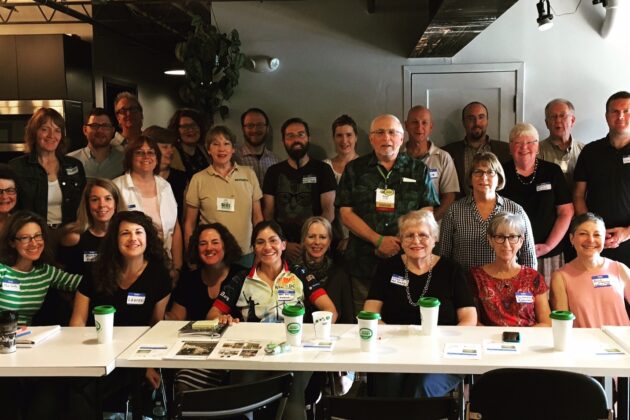
Sustainable Jersey Regional Hubs meet to advance collective leadership
What drew leaders from Sustainable Jersey’s Regional Hubs to an indoors five-hour gathering on a recent beautiful fall Saturday?
Consider the range of responses ticked off as we went around the room:
- “I want clean water, clean air and clean food to be available on my 104th birthday.”
- “I need new ways of organizing people to address our issues.”
- “I get energy meeting other people with a shared passion for sustainability.”
- “Because sustainability is no longer a choice, it’s a must. The planet is warming and the consequences are dire.”
The people who attended the meeting are leaders in their community working with their individual municipal green teams, sustainability organizations and as part of a Sustainable Jersey Regional Hub. Nearly half of the attendees have been named a Sustainability Hero for their outstanding accomplishments as part of the Sustainable Jersey recognition program. Overall, these folks are not flashy attention seekers — they are committed, hardworking individuals who have prioritized sustainability as an issue they value.
Strengthening green teams through regional hubs
Sustainable Jersey works with eight active regional hubs: Atlantic-Cape May Hub, the Hunterdon Sustainability Team, the Mercer County Sustainability Coalition, the Middlesex County Hub, the Monmouth County Hub, the Somerset County Green Leadership Hub, Sustainable Essex Alliance and the Tri-County Sustainability Alliance (Camden-Burlington-Gloucester).
To make New Jersey more sustainable, we need our green teams to have the ability to think together and to cooperate across community borders. To tackle our biggest challenges, it will take the leadership of many individuals working towards a similar goal on a collective scale. Building committed teams of leaders is the underlying goal for the regional hubs and the meeting.

In 2014, Sustainable Jersey started the regional hubs as a way to help green teams build capacity through training, best practice resources, and networking. In keeping towns connected to each other, green teams gain the opportunity to learn what has been successful elsewhere in the state and partner on projects with neighboring towns and schools in order to boost limited resources.
The hubs are independent and approach issues in different ways. For example, the Somerset County Hub is led by the county staff, while other hubs are completely volunteer driven. Some of the hubs are focused on mentoring towns in their region and other hubs are working on projects like community energy aggregation in Essex County and a regional Arts and Creative Culture Team in Hunterdon County.
Resources are shared like the plastic bag monster costume that is used across the Tri-County Sustainability Alliance members and worn at different community events to further plastic bag reduction awareness. Some hubs have logos and extensive social media while others have regular social events. For example, the Atlantic Cape May Hub has a green team mixer planned for October 3, 2017 at the Little Water Distillery in Atlantic City, register here.
Tenacious change is change that sticks, stays and is “roll back” resistant
For the September 16, 2017 Regional Hub leader gathering in Asbury Park, Sustainable Jersey brought in Tom Klaus, of Tom Klaus & Associates to share his ‘Tenacious Change” initiative. Tom’s work is based on original community engagement research on the Roots to Fruit of Sustainable Community Change framework.
Tom describes tenacious change as positive community change that is resistant to snapping back to the way things were before. It is an approach to organizing and working together to solve complex social problems through collective leadership, community engagement and coordinated action.
Tom walked the regional hub leaders through the two key aspects of community change. First, the “roots” are the community’s infrastructure and key stakeholders needed for the change to happen and then the “fruit” of community change are the acts of community engagement and mobilization. The community engagement work focusses on building relational trust through social networking and leveraging personal relationships. In other words, sending out a promotional mailer alone will not build a committed community of sustainability enthusiasts that will stick. It takes time and relationship building.
Tom said there are two groups to engage and mobilize: the content experts and the context experts. Context experts include the citizens, population or groups that are most directly impacted by the issue or problem and the “grass root” influencers like the gurus and citizen leaders. The content experts are the professionals, providers, program partners and the “grass top” influencers such as the funders, business leaders and elected officials.
The discussion was lively and the participants walked away with new tools. The group especially liked a three-minute video that Tom shared called Leadership Lessons from Dancing Guy – How to Start a Movement. It is definitely worth a watch!
Sustainable Jersey will report the success stories of the regional hubs moving forward and annual meetings are in the works for the hub leaders. The hubs are a powerful force in sustaining the sustainability movement in New Jersey. Sustainable Jersey is lucky to be working with these individuals who understand that community engagement leads to community change.

For more about Sustainable Jersey: Website Facebook Twitter Instagram LinkedIn
